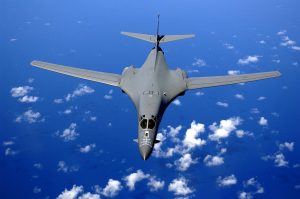The Stream - Tuesday August 16, 2016
by Ryan Pickrell

For the first time ever, the U.S. is deploying three different types of heavy bombers to Guam.
These deployments are likely in response to alleged Chinese and North Korean provocations, and both countries have expressed outrage and anxiety over the presence of such weapons in the Pacific.
With these factors in play, the U.S. sent a collection of B-1 Lancers to the Pacific Aug. 9 to replace the B-52 Stratofortresses already stationed in Guam. The new B-1 bombers will contribute to the Pentagon's Continuous Bomber Presence (CBP) mission, according to military news source, Stars & Stripes. This is the first time the U.S. has deployed B-1 bombers to Guam since April 2006.
Four days later, the U.S. Air Force announced that a group of B-2 Spirits had been sent to join the other aircraft on Guam. These aircraft will be incorporated into U.S. "bomber assurance and deterrence deployment" (BADD) efforts.
The B-1 Lancer can fly more than 900 mph, faster than the speed of sound, and carry 75,000 pounds of munitions, and the B-2 Spirit can skirt most advanced radar systems.
Not only is this the first time that the U.S. has stationed three different types of heavy bombers at Anderson Air Force Base on Guam, but this is also a significant show of force in a region fraught with contention, argued Joseph Trevithick in a recent "War Is Boring" article.
Writing on Twitter, U.S. Air Force Secretary Deborah Lee James said, "This unique situation provides a valuable opportunity for our bomber crews to integrate and train together, as well as with our allies and partners through the region in a variety of missions," reports the Japan Times.
Lieutenant Colonel Seth Spanier, commander of the 34th Expeditionary Bomber Squadron, reportedly informedthe Stars and Stripes that "the Pacific is going through a time of increasing instability and tensions. I think bringing the men and women of our B-1s to the area ... will provide a visible assurance to our allies and partners."
Not only did the deployment of heavy bombers to the Asia Pacific region send a strong message to American allies, but it also sent clear warnings to North Korea and China.
Following the recent deployment of B-1s and B-2s to support the B-52s in Guam, the Korean Central News Agency reported, "The U.S. imperialists are getting ever more undisguised in their scenario for a preemptive nuclear attack on the DPRK ... These military moves only harden the will of the service personnel of the Korean People's Army to take merciless retaliatory counteraction against them. A preemptive nuclear strike is not a monopoly of the U.S."
China argues that the U.S. heavy bombers in Guam were sent there as a challenge to China's growing presence in the region. Chinese military expert Yin Zhuo, during a recent interview with CCTV, pointed out that the B-2 stealth bomber has an operational radius of 6,000 nautical miles; however, aerial refueling could extend that number to 10,000 nautical miles.
Given that Anderson Air Force Base is only 1,800 miles from China, Yin asserts that the deployment of B-2 bombers to the Pacific has given the U.S. the ability to carry out a nuclear strike or a high-precision strike against any Chinese target. He argues the bombers in Guam could be used to cripple China's anti-access, area denial strategy.
North Korea has conducted a number of illegal ballistic missile tests, and China has been expanding its military presence into the East and South China Sea. The U.S. has regularly criticized provocative actions of both China and North Korea. The presence of U.S. heavy bombers in the Asia Pacific will further reinforce America's role as a security guarantor and put pressure on states that engage in actions and behavior outside of the current international legal framework.
Send tips to ryan@dailycallernewsfoundation.org.
Copyright 2016 Daily Caller News Foundation
Read More Here
No comments:
Post a Comment